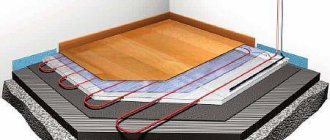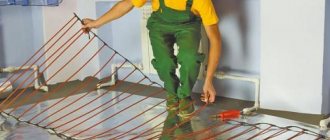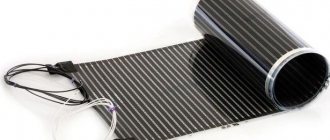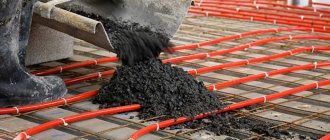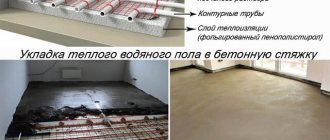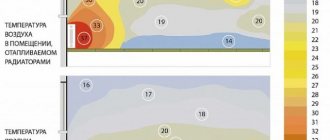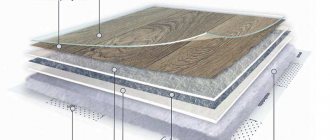What are the advantages of a heating system
Humanity is faced with the question of saving energy; it is necessary not only to save energy, but also to improve the system to minimize heat losses. Modern homeowners are trying to purchase economical heating boilers, and from personal experience we can confirm that high-quality modern boilers are capable of operating in an economical mode. In this article we will tell you about an additional way to save heat in your home. Traditional types of heating in the form of radiators and heaters that produce the required amount of kilocalories of heat are beginning to give way to innovative developments of heating systems. Using a radiator heating option has a number of disadvantages: the wall on which the heating radiator is located heats up and dries out, while other walls remain cold. Therefore, cold floors and walls create a feeling of cold and discomfort. The “Warm Plinth” heating system can confidently be called a leader in heating systems, capable of changing the convection currents in the room and, naturally, the microclimate.
What to choose?
Having considered both heating options, it is difficult to make a choice right away, so it is worth learning about the advantages of each type.
Heating floor
- It is economical, especially when compared with batteries.
- The underfloor heating system is durable, especially water-based.
- A variety of floor coverings when equipped with floor heating.
- Can be used in any room.
- Heating elements are hidden from view.
- The floor surface is heated evenly.
- The degree of heating of the room is easy to adjust.

Heated floors will bring comfort to your home
Skirting
- There are no temperature changes in the room.
- Not only the air warms up, but also the walls, which gives greater efficiency.
- Installation can be carried out even by a non-professional: this does not require significant intervention in the structure of the room.
- The response time – that is, the start of warming up – is minimal.
- It can be painted.
- Repairing a breakdown is simple.
- Provides inexpensive, efficient heating of large rooms.

Heated plinth in section
Read with this
- Warm electric baseboard
- Air heating system: efficient heating and air conditioning
- Why do you need a plinth for heating pipes?
- Heating system for a private house in Leningrad and its diagram
- Glue for polyurethane skirting boards: types of glue, calculation of quantity and step-by-step instructions for gluing joints and ceiling skirting boards
- Do-it-yourself heat accumulator: making a heat accumulator for heating step by step
- Manifold diagram of the heating system. what is superiority?
- Providing heat to apartment buildings: centralized heating system
- Making a fireplace out of boxes for the New Year with your own hands
- What to do if the heating battery is leaking
Kinds
Today, only two types of warm baseboards are common - water and electric. Each of them is used in the specific conditions of the arrangement of rooms and the furnishings of the apartment itself. It is worth considering each of the types in detail.
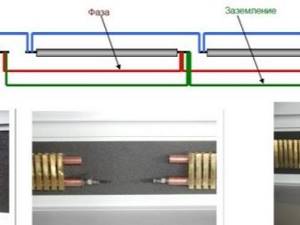
Water
This installation option is quite common - it can be seen in the interior of some modern residential buildings, office premises, even shopping centers. It is worth noting that the water type of warm baseboard has become widespread in many Western countries. This interest is due to factors such as: ease of use and low maintenance requirements. A warm water baseboard is an externally metal panel or box, inside of which a heating or heating module with mini-pipes for supplying water and heating is placed. The outer or back side of the device is also equipped with a metal panel, which is already designed to protect the wall itself from high temperatures.
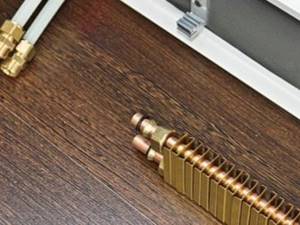
This method of connection is called beam by technicians. The difference between this type of warm baseboard and electric one is the wide range of possible installations in the interior. Warm water baseboards can be installed in attics, loggias, even on balconies, while the heating efficiency does not decrease, and energy costs remain relatively low. Another feature of the water type is the speed of heating of the air, since the physical properties of water allow even the hottest flows to be passed through pipes without hindrance. However, it is necessary to constantly monitor the temperature level in boiler rooms.
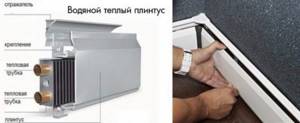
Electric
If the water type of warm baseboard is valued for its quick heating and ease of maintenance, the electric type is widespread due to the following characteristics:
- ease of installation work - unlike the water type, the electric type is installed on site, the installation process is simple and quick, because it is enough to fix the heating panels to the wall;
- the presence of more advanced heat regulation systems - most models of water baseboards are not equipped with special devices for measuring temperature - for this it is enough to monitor the average water level in the boiler rooms. The electric type is often equipped with specialized thermostats, which are similar to ordinary thermometers. Thermostats can operate either automatically or can be adjusted manually, and their work is aimed at optimizing energy costs.
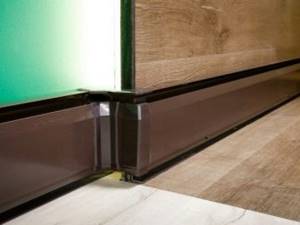
It is also worth noting the negative aspects of using such a plinth:
- high energy consumption - when using any equipment with power supply, the question of monetary costs arises. The electric type, unfortunately, even with thermostats, consumes a large amount of energy;
- installation of the electrical type is much simpler, however, the connection process itself can cause some difficulties - this is the preparation of a dedicated line with the correct rating;
- One potential downside for many buyers is the power supply. The likelihood of damage to the wiring and a fire is extremely low, however, for some this is the determining factor under certain operating conditions.
If the buyer liked the water variety more, then do not despair and think that these species differ in external characteristics.
Apart from the presence of terminals or wire attachments to the electrical supply, these varieties are absolutely similar in appearance. It is worth noting this type of baseboard equipment as infrared warm baseboard. The peculiarity of this type is the use of a special film tape, which heats up under the influence of high temperatures and becomes a kind of source of infrared radiation, which provides additional and high-quality heating of the room.
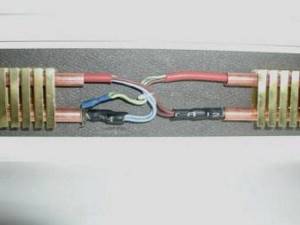
Pipe layout classification
To achieve maximum efficiency of the coolant in the radiator, you should carefully approach the installation. There are several types of heating system wiring, differing in design and number of pipes involved.
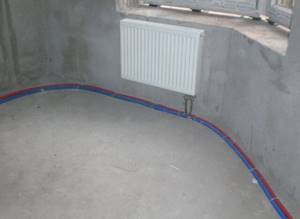
Classification of heating system wiring:
- plinth
- single-pipe;
- two-pipe;
- collector
There are also four options for mounting circuits:
- Hidden. In this case, the pipes are recessed into grooves in the wall or screed.
- Open. The pipes are placed outside, this option is less labor-intensive.
- Vertical.
- Horizontal.
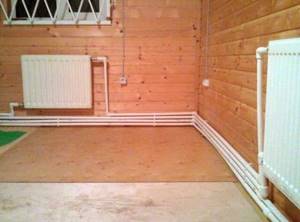
Natural and forced flow of water in the pipeline is possible.
- Open. In this case, the expansion tank comes into contact with the environment. Because of this, you need to constantly monitor the water level in the middle.
- Closed. In this design, constant internal pressure is usually established. The expansion tank includes a rubber bulb with a metal casing. In this case, the liquid does not come into contact with the external environment.
1. Design and principle of operation of a warm baseboard
We can say that a warm baseboard is a fundamentally new approach to the issue of heating an ordinary apartment or private house. This system received this name due to its visual similarity to the usual baseboard and its compact size. Externally the design is:
- an aluminum box consisting of three walls - top, bottom and front;
- The thickness of the box is no more than 3 cm;
- The height of the front panel ranges from 10 to 24 cm;
- For decorative purposes, the ends of the box are closed with special plugs;
- Inside the box are heating elements that are attached to the wall using mounting brackets.
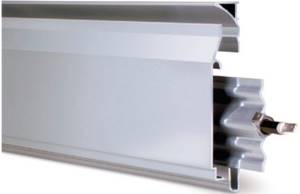
Anyone who has been more deeply interested in economical methods of heating their home knows that the same radiators heat the room by convection. That is, the heat emanating from their surface heats the air. In this case, hot air rises up to the ceiling, where a thermal cushion is created, which displaces cold masses down. In rooms with low ceilings, this difference is not very noticeable and, in principle, comfortable conditions are created. But in rooms with high ceilings it is necessary to use forced ventilation, which will help mix air masses of different temperatures and warm them up as quickly as possible. In this case, most often in the corners of the room the air will still remain cold. Thus, warming up the entire volume of air in a room requires higher temperatures and longer times. Heat loss is 20-30%.
Surely, when using electric oil convectors, you noticed that next to the heater you feel warm, even hot, but literally a meter away from it the air is cold. In addition, the air becomes dry and foreign odors can often be detected.
The operation of a warm baseboard is based on gradual, uniform heating of adjacent walls and floors. Heating the air by convection uses no more than 30% of the radiated heat. Warming begins from the lower layers of air. The heat then slowly “creeps” up the walls, heating their surface in the process. Thanks to this, it became possible to achieve the same temperature throughout the entire height of the room.

thermal curtain.
Heat loss when using warm baseboards is only 5%. Needless to say, this method is economically beneficial? It has been proven that when walls are heated to a temperature of 37-38°C, a person becomes warm and comfortable even though the air temperature in the room is 16-17°C. A warm baseboard can be used as a complete heating system. Then you need to install it around the entire perimeter of the room. It can also be used as an additional source of heat in places where installing conventional radiators is impossible. For example, for heating a loggia with French glazing.
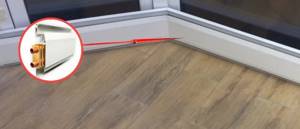
Double-glazed windows will not interfere with the full operation of the system. The warm baseboard is safe
Advantages and disadvantages
In order to give an objective assessment of skirting boards for heating pipes, it is worth studying the positive and negative aspects of such a floor system.
Among the advantages of the design, the following specific features stand out:
- Heat distribution in the room occurs in uniform flows over the entire area. The positive properties of infrared radiation include the ability to heat only translucent objects.
- The human body perceives such heating as a natural process.
- During heating, the bases acquire a temperature that is almost the same as the normal human body temperature. Therefore, imbalance when interacting with devices is eliminated.
- All bases, including walls, ceilings and windows remain dry, condensation does not accumulate on surfaces, which is especially important for rooms where panoramic windows are installed.
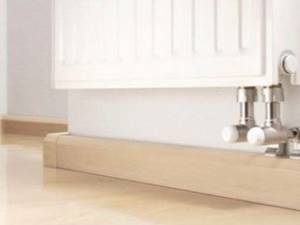
- The installation and installation of the system does not require the involvement of specialists, since the installation work is not particularly difficult.
- The presence of attractive decorative elements in the room has a positive effect on the overall interior.
- This design can be additionally equipped with thermostats, which will allow you to constantly maintain the optimal temperature inside.
- The average temperature of the coolant does not have a negative impact on heating productivity, since it becomes possible to save about 30% of the energy spent on heating.
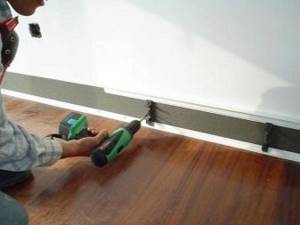
Like any design, such a system has disadvantages. These include the following points:
- The length of the heating circuit hidden under the baseboard cannot be more than 15 m. Increasing it will lead to a decrease in the efficiency of the heating system. For large buildings, the question of using distribution manifolds will arise.
- Gaps in baseboards should not be blocked to maintain uniform heat flow.
- It is not allowed to install various decorative elements on the product, which may adversely affect the level of heat transfer.
- The price of the structure is quite high, since expensive raw materials are used during its assembly.

Types of heating baseboards
Structurally, the baseboard heating system consists of a heating module covered with a decorative aluminum strip. The heating module consists of two copper tubes on which aluminum plates are mounted. Copper is known to have high heat transfer and high resistance to corrosion, but has a high price. Aluminum also transfers heat well and is much cheaper. This copper + aluminum combination is used in many heating devices and has proven its effectiveness.
Read about copper and copper-aluminum radiators here.
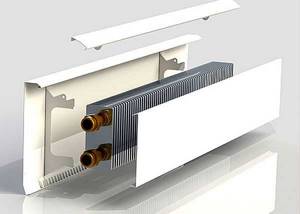
This is a baseboard heating design
There are two ways to heat the heat transfer module: using a coolant (water or antifreeze) and an electric heating element. On this basis they differ.
Electric heating
Special low-temperature heating elements are inserted into electric baseboards. They heat up to a maximum of 60 oC. At the same time, their power is more than enough: one linear meter produces about 180-280 W. Electric heaters are inserted into the lower tube, and a cable in a special sheath is laid into the upper tube. With its help, voltage is supplied to all sections of the heating element. The length of one is from 70 cm to 2.5 m, and from different lengths of heaters the power necessary to heat the room is collected.
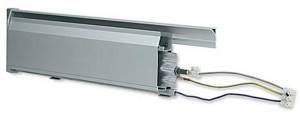
A special heating element is inserted inside the copper tube. This is how you get an electric warm baseboard
Water warm baseboard
When using water or antifreeze to transfer heat, the same modules are connected into a single heating circuit. There is only one limitation: for maximum heating efficiency, the length of one circuit should not be more than 12.5-15 m (different lengths for different manufacturers).
If there are several circuits for installing a warm water baseboard system, it is convenient to connect a collector (comb). You can use the most common model or with flow meters - it’s your choice. Heating modules for the water heating method are selected based on the required power for a specific thermal pressure of the system.
Calculation of the length of the heating element
Table of dependence of the power of a warm baseboard on the temperature delta (thermal pressure)
For example, at ΔT = 37.5 oC to compensate for room heat loss of 1500 W, the thermal power (according to this table) is 162 W. This means that you will need 1500/162 = 9.25 m of heating element.
What and how to connect
Having gained the required length in total, distribute it around the perimeter of the room, combining it into closed contours. Heater sections are connected to each other in several ways:
- flexible stainless steel pipes with union nuts or under a press;
- copper pipes and fittings for soldering;
- copper or brass threaded fittings.
The most reliable connection method is copper pipes for soldering. This option is also suitable for central heating systems, since such connections can withstand up to 30 bar. The most difficult thing to do is assemble with threaded fittings: the dimensions and distances between the tubes and from the wall are small, making it very inconvenient to work. Flexible pipes must be chosen that are reliable: heating and hot water require good quality.
Connect the heating elements of heating baseboards using hoses and copper pipes
The line from the boiler or floor comb must be made of materials compatible with copper: polymer (polyethylene and reinforced polypropylene), metal-plastic or copper pipes.
System Features
The system is compatible with boilers of any type using any fuel. But there is one feature: for normal heat transfer, a high speed of coolant movement is required. With natural it will simply be ineffective
Therefore, it is important to choose the right pump.
https://youtube.com/watch?v=oXe3HHR43oo
Heat plinth: design features
It became possible to buy a warm baseboard not so long ago. In fact, this system was designed with the aim of increasing heating efficiency while using less energy. Moreover, such panels look very original, and warm baseboard technology often allows you to completely abandon the use of traditional heating methods using radiators.
Externally, the heating panel looks like an ordinary floor plinth
Externally, the heat plinth is a strip made of aluminum that covers the internal contents of the box. If it were not for its very modest dimensions, one could call it a full-fledged heating device, however, the fact that the box has a low height, does not protrude much from the wall and is mounted along the perimeter of the room on the wall near the floor gives it the right to be called a plinth.
Inside the box there is a heating system, which may differ depending on the type of baseboard chosen. You can understand what the difference is by considering the existing types of warm baseboards.
The principle of operation of baseboard heat as a heating device
Obviously, this heating device got its name due to its location. The warm baseboard is attached in the same place as a regular one - around the perimeter of the room. The main advantage of such a heating system is that the device heats not only the air around it, but also the walls with which it comes into contact. This system allows for better heat retention and reduced heat loss.
The fact that air convection is reduced and the heat is evenly distributed throughout the room, without concentrating in one place, as is often the case with traditional radiators, also has a positive effect. A significant advantage is that due to the slow movement of air from the baseboard to the ceiling, dust practically does not rise from the floor. And this not only makes cleaning much easier, but also has a positive effect on the health of residents.
An electric warm baseboard was used to heat the room.
The temperature limits within which the device operates are 40-70 degrees and using a thermostat you can set the indicator within these limits. According to reviews from the owners, a warm baseboard never allows the air temperature to drop below 20 degrees, and this can be considered a completely comfortable temperature for living. Of course, this applies to cases where the calculations of the required number of elements and their power were carried out correctly.
If we are talking about installing an electric baseboard, then it is also worth noting the fact that, like one section of any traditional radiator, one segment of a warm baseboard emits 190 W of heat. At the same time, the energy consumption for its production is 3 times less, and this is a considerable saving for the entire heating season.
As a heating device, a warm baseboard can be installed in almost any room. Neither the size nor any location of the room can serve as a contraindication to its installation. It is generally accepted that this design option is ideal for rooms with panoramic glazing, where ordinary radiators under the windows simply will not fit.
Warm baseboard is an ideal solution for installation in a room with panoramic windows
This is interesting: Long-burning pyrolysis boilers with a water circuit
Popular models and estimated cost
Buying one of the popular models of warm baseboards, for example, Melodie or Verlys Evolution, today is not a problem even if you order online. But the cost, depending on the store, salon or company where it is purchased, can vary significantly, which makes the search for the optimal option far from a waste of time.
On average, the estimated cost of a linear meter of the system starts at $30. When choosing between a more or less powerful system, you must take into account the fact that it can consume a significant amount of electricity, for which you will have to pay every month.
It is difficult even for a specialist to roughly estimate the cost of purchasing and installing such equipment, because this is a whole system that has a large number of components: aluminum profiles, heating elements, thermostats, sensors and power cables, the number of which may vary for each individual room.
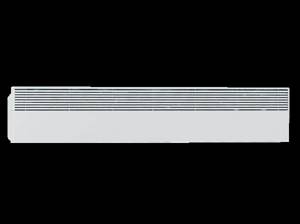
The only criterion that gives a more accurate idea of the cost may be the area of the room planned for heating and, accordingly, the power of the equipment required for this. So the Melodie Evolution model with a power of 500 W will cost 23 thousand rubles, and the 1000-watt Verlys Evolution version costs 41 thousand rubles.
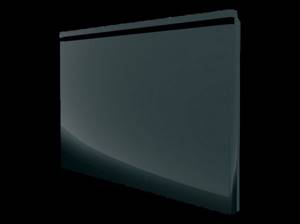
Melodie Evolution:
- It heats well, definitely no worse than apartment heating systems.
- Hooray, you no longer need to carry a foot warmer around the room with you, this system copes 100%.
Verlys Evolution: I have small children, a girl and a girl, who used to constantly catch colds and get sick, although the room seemed even stuffy. The thing is that there were very strong drafts on the floor, and the children often played while sitting on the rug. We wanted to make a heated floor at first, but then we were told that it would be much cheaper to buy a system of mini-plinths with electric heating. It didn’t cost us much, without unnecessary hassle, and most importantly, it solved the problem of the microclimate in the children’s room.
Advantages and disadvantages: expert opinion
One of the advantages is undoubtedly its neat, almost decorative appearance. Radiators, even in size not much different from ordinary baseboards, take up very little space and are located where they do not disturb anyone - on the floor, near the wall. This means that there are more options for arranging furniture, and curtains can hang freely without clinging to the ribs of traditional radiators.
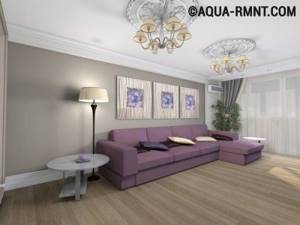
The warm baseboard has a modern look, takes up little space and fits into an interior designed in almost any style: from country to modern
Another advantage of the baseboard heating system is uniform heating of the entire area of the room. There are no zones of warmer or cooler air because there is no convection. Consequently, the temperature of the air gap under the ceiling and near the floor will be the same, and this has a beneficial effect on both human health and the condition of finishing materials.
Don't forget about saving. Fuel consumption is noticeably reduced due to the low heating temperature, by an average of 35-40%. In addition, the installation of skirting equipment is quick, as is its repair. It is possible to install a separate thermostat in each room and use it to control the heating: in the children's room, set the temperature a little higher, in the bedroom - a couple of degrees lower.
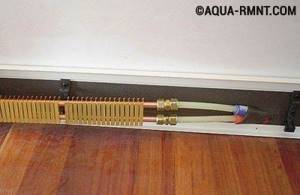
It is not recommended to create elements of a warm baseboard with your own hands, since there are no guarantees of its proper and efficient operation. It is better to purchase expensive but high-quality equipment from a well-known manufacturer
The disadvantages include the high cost of the equipment - about 3 thousand rubles for each meter. This amount includes special materials and installation of the system. Installation of equipment must be carried out by competent specialists who have permission from the manufacturer. By installing the system yourself, you can miss a number of important points, which will lead to rapid wear of the equipment and constant repairs.
It is advisable that baseboard radiators are not covered with anything: neither decorative overlays nor pieces of furniture. Heat transfer decreases sharply, and heating of the room becomes inadequate.
Despite some shortcomings, warm baseboards are becoming increasingly popular, and the time is not far off when it will completely replace today’s traditional convection-type systems.
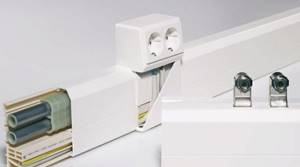
Systems used for home heating are constantly being modernized and modified. Modern designs occupy a minimum of usable space and also effectively cope with the task. Such devices include the “warm baseboard” system.

Advantages of using warm baseboards
The use of such a modern heating system provides many advantages for consumers, namely:
- the ability to save free space due to its compact size, which is very important for small rooms;
- creating comfortable conditions for all living things in a heated room. The warmth of the baseboards provides an optimal microclimate for humans, animals and plants. Especially warm plinth is suitable for corner apartments, where, if used, the walls will be completely warmed up and thus you can forget about the fungus;
- no condensation on the windows and uniform heating of the entire room;
- due to the absence of convection currents, as with traditional heating, the level of dust in the room decreases;
- high efficiency at work;
- absolute safety and ease of operation;
- ease of installation and the ability to fit into any interior due to the variety of designs and color schemes;
- energy savings, which is approximately 40%;
- affordable price.

Do-it-yourself installation of warm baseboards
In addition to the high cost of the system itself, you will also have to pay a significant amount for its installation. In this case, the calculation is made for each linear meter. Based on this, many people have a question: is it possible to install a warm baseboard system yourself? We can say that if you have the skills to work with electrical wiring and plastic pipes, as well as due attention and legibility, this is not so difficult to do.
Self-installation of warm water baseboard
To carry out the work you will need the following materials:
- Metal-plastic pipes;
- Thermal insulation material;
- A collector equipped with taps;
- Metal and plastic adapters;
- Set of tools.
Installation should begin with the installation of the collector. It is necessary to connect a pipe to it, which will provide its power. A boiler running on any type of fuel can be used as a source of coolant. The only condition is that for the system to operate correctly, it is necessary to provide a pressure of at least 3 atm. After you calculate the required length of the plinth according to the recommendations from point 6, you can begin laying the pipes.
It must be remembered that the maximum length of the circuit should not exceed 12.5 or 15 m depending on the manufacturer
And that there should be two pipes in the system - one for supply, the other for coolant intake;
It is also important not to forget about thermal insulation to reduce heat loss. To do this, you need to lay special material around the perimeter of the room between the wall and the pipes; Now you need to screw the base to which the heat exchangers will be attached
The plank is attached using self-tapping screws. Please note that the finished baseboard should not lie flush to the floor. Leave a gap of about 1 cm to prevent the device from overheating;
Now secure the modules and connect them together using crimp fittings; When the structure is assembled, you need to connect it to the common highway by installing a collector; Before final assembly, be sure to check the system for leaks. To do this, perform a test run, which will also show the correct operation; If the system works reliably, secure the front panel to the baseboard. This is very easy to do, following the recommendations in the instructions.
Self-installation of electric heated baseboard
Installing an electric baseboard requires completely different skills and attention to slightly different factors. It is recommended to connect the system directly to the panel and equip it with a separate circuit breaker. How many circuits there will be in your apartment or house, there should be as many separate lines. Choose wires with a large cross-section that can definitely withstand the load (at least 2.5 mm). Do not forget about the need to connect a thermostat for each circuit and a temperature sensor for each room. This will help set the most optimal temperature for each room.
- The installation should begin with the laying of thermal insulation material;
- Then screw the base of the plinth;
- Attach heat exchangers to it;
- Make a parallel connection of wires;
- Carry out a thorough visual inspection to ensure there are no uninsulated areas;
- Close the structure with the front panel;
- Connect the heating circuit to the thermostat and connect it to the distribution panel;
- Perform a test run of the system.
The gap from the floor to the baseboard should be at least 1 cm, and the distance from the wall at least 1.5 cm. This will ensure proper convection and protect the system from overheating.
Approximate prices
Many people are interested in how much a warm baseboard for an apartment or house will cost. It is impossible to answer this question accurately, since the cost depends on several factors - manufacturer and type of product:
- For example, electric skirting boards from Mr. Tektum can be purchased from 10,000 rubles per module, but water ones will cost a little less - from 8,000 rubles per module. This is a domestic manufacturer, which for some is of great importance. If the word “module” confuses you, then the price per linear meter will be a little more than 4,000 rubles.
- Devices from another Russian company, Megador, are also presented on the market. The cost of the heating element depends on the length. The price of one meter starts from 2000 rubles.
- But you can buy skirting boards from the Australian company Best Board for less than 4,000 rubles per 2.5 meters.
Homemade heating device
Installing a circuit is a complex technological process that requires a professional approach and experience. It should be entrusted to a master who has undergone special training. To save money and not worry about the final result of the installation, you can do the work yourself. This method will save a large amount, but will not guarantee the high quality and reliability of the heater.
The installation principle is similar to working with a classic heating radiator. Install a wall panel for convectors above the floor. Attach the baseboard heating elements with self-tapping screws. The next stage is installation and connection of parts into a single composition using crimp fittings. Similar to working with metal pipes.
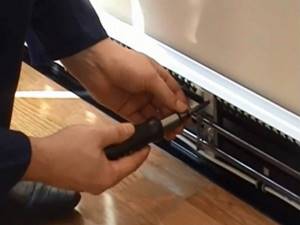
The heating circuit is connected using a collector to uniformly heat the house and apartment. The length of each is 13 cm, which is similar to a warm floor
It is important to check the functionality of the installed heating device in order to achieve automation of heating control. Check the connections, close the water floor elements and start using
To install aesthetic structures, use ready-made decorative panels. Installing the panels will allow you to cover the heating devices and achieve harmony in the interior of the space.
Installation of a water baseboard heating system
Among the main elements of heating with a water heat carrier are a warm baseboard radiator unit, a distribution manifold, and plastic pipes that do not allow oxygen to pass through. The warm baseboard radiator block consists of a heat exchanger and an aluminum box. The heat exchanger is formed from two copper pipes with an outer diameter of about 13 mm and a wall thickness of 2 mm. Vertical lamellas made of aluminum or brass are attached to them. The aluminum box includes three strips, which are profiled by hot extrusion: a strip of upper and lower fastening, a front cover. The box has a width of 22 mm and a height of 140 mm. The distribution manifold includes two parallel steel tubes, which contain leads, inlets, air vents, shut-off and drain thermal valves.
Water baseboard heating
In the process of constructing baseboard heating, a special plastic tube is used. Thanks to this element, the coolant is delivered to the radiators and is also removed from them. Part of the heating circuit is placed in the floor and passed through the walls, and with the help of an external corrugated pipe (which covers the internal one) it is possible to replace the internal pipe that conducts the heat carrier without opening the floor.
Also, when building baseboard heating, it may be necessary to equip it with additional devices - thermomechanical or thermoelectric thermostats for radiators, a servo drive on the distribution manifold, a circulating water pump, a pressure gauge, a thermometer at the coolant inlet to the manifold.
Design and scope of warm skirting boards
Baseboard heaters have quite high decorative qualities. They are quite compact and pleasant to look at, which allows them to be used to implement a wide variety of design solutions. The plinth system is also good because it requires little space for its installation, so there is no infringement of free space in the room.
Due to their characteristics and heating method, baseboard-type heating devices can be placed next to any objects located in the room - as long as they do not interfere with the movement of warm air. In addition, the type of devices in question can be installed regardless of the materials used to make the floors and walls.
On the heating market, baseboard radiators are presented in a wide range of colors, and choosing the option that best suits a specific interior is not difficult. In addition to devices with a smooth surface, you can also find those whose surface will imitate the texture of various materials - stone, marble or wood.
The greatest efficiency from the use of baseboard radiators is achieved when they are installed in corner and end rooms, which are often the coldest. Baseboard heating will compensate for the lack of temperature. The type of heating system under consideration can be used with equal success both in private houses and in apartments - for example, for heating balconies.
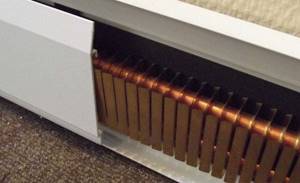
Varieties of warm baseboards
Today, two types of warm skirting boards are sold on the market:
- water;
- electric.
Typically, representatives of both categories are significantly superior to traditional heating methods, but today we will pay more attention to electric models. This is explained by the fact that in most of the villages there are no other sources of energy other than electricity. Of course, it is always possible to organize a heating system using liquid/solid fuel, but it will not be cheap, and certain difficulties may arise (with space for fuel storage, with system maintenance)
It is easier to use electrical equipment to heat a room. And from this point of view, an electric baseboard is the most optimal and effective option. Let's take a closer look at this option.
Of course, it is always possible to organize a heating system using liquid/solid fuel, but it will not be cheap, and certain difficulties may arise (with space for fuel storage, with system maintenance). It is easier to use electrical equipment to heat a room. And from this point of view, an electric baseboard is the most optimal and effective option. Let's take a closer look at this option.
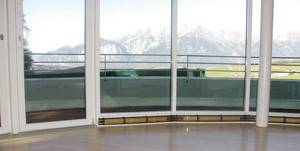
Externally, the electrical system is practically no different from the water one. This is, in principle, an aluminum strip 30 millimeters wide, as already mentioned in the previous paragraph of the article. The height varies between 100-240 millimeters. As for color and shape, they can also be different.

At the same time, the water plinth is a structure made of tubes with stiffening ribs mounted on it, while the electric plinth is an ordinary heating element. The tube itself is quite long (the element takes up almost all the free space inside the case). We also note that the heating element with which the warm baseboard is equipped is made from a special heat-resistant alloy. Thanks to this, the service life also increases.
Such skirting boards are connected to an outlet, but experts recommend equipping a separate branch for the device from the panel, and also installing an automatic machine.
The modern market for thermostats is very extensive, so, of course, it’s up to you to decide. After all, the cost of the device directly depends on the ease of working with it and the complexity of its implementation. But most buyers prefer models that do not create unnecessary hassle during use. For this reason, it is advisable to choose thermostats that can not only control the temperature in the room, but also program work for the whole day (or even for the next couple of days).
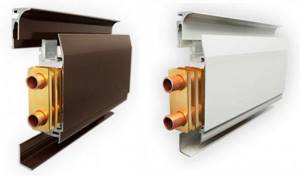
Principle of operation
Like conventional heating devices, the main task of a warm baseboard is to heat the room, but the very principle of its operation is very different from standard heating devices, which only due to high heating transmit heat into the surrounding space.
The baseboard heating system meets the most modern requirements for energy saving and respect for the microclimate of the house.

It is based on several operating principles:
- The first of them is that they install it, like an ordinary decorative plinth, around the entire perimeter of the walls of the home.
- The second principle is to ensure heating not only of the air in contact with the baseboard, but also of all the walls of the house along the perimeter of which it is mounted, which means that the heated walls will stop consuming heat from the surrounding space and will become an insurmountable barrier to the cold.
- The third principle is to ensure uniform air convection in the room, that is, heat is distributed evenly even between the floor and ceiling, which means that in such a room you will not need to simultaneously sweat in a T-shirt from the stuffiness and freeze in warm socks due to the creeping semi-cold.
- And finally, which is important for housewives who care about cleanliness, the rise of warm air from the floor does not occur very quickly, which means that clouds of dust will not rise with it.
In general, this entire plinth system works on the effect of “sticking” the air heated by it to the surrounding surface, the largest of which in terms of area in the house is the wall.
Baseboard radiators are installed around the entire perimeter of a house or apartment where heating is required. The heating elements are built into metal boxes with a lower inlet slot for cold air and an upper outlet for warm air.
At the same time, they do not easily throw warm air into the surrounding space so that it somehow mixes there and warms up the room. And they represent a finely regulated microclimate system, since a warm flow is purposefully released along the wall, so that it can then heat the entire room as evenly as possible. Current- and heat-conducting elements of such equipment are made of non-ferrous metals: copper and aluminum.
The heating elements themselves operate at temperatures ranging from 40 to 70 degrees Celsius, transferring a significant portion of this heat to the wall. Therefore, there is no need to heat the radiators in the baseboard to the maximum, because even with a regulator value of 40 degrees, the wall can warm up to the temperature of the human body, which is absolutely safe even for children.
